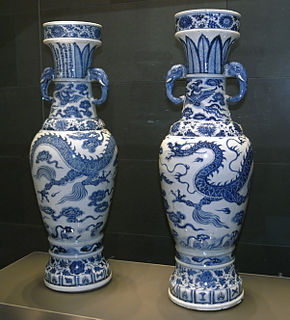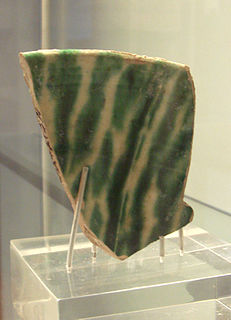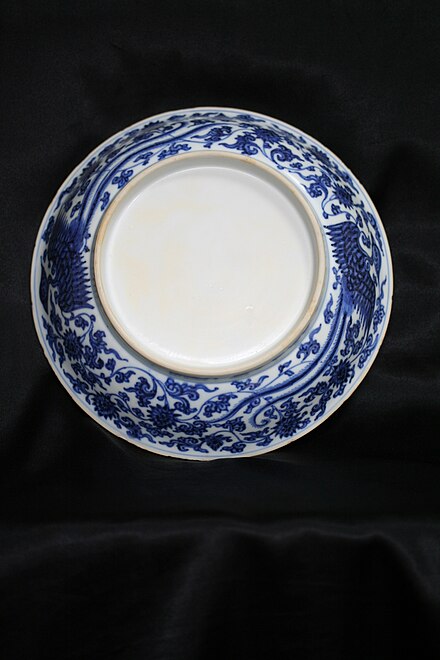
Longquan celadon (龍泉青瓷) is a type of green-glazed Chinese ceramic, known in the West as celadon or greenware, produced from about 950 to 1550. The kilns were mostly located in Lishui prefecture in southwestern Zhejiang Province in the south of China, and the north of Fujian Province. Overall a total of some 500 kilns have been discovered, making the Longquan celadon production area one of the largest historical ceramic producing areas in China. "Longquan-type" is increasingly preferred as a term, in recognition of this diversity, or simply "southern celadon", as there was also a large number of kilns in north China producing Yaozhou ware or other Northern Celadon wares. These are similar in many respects, but with significant differences to Longquan-type celadon, and their production rose and declined somewhat earlier.

Pottery and porcelain, is one of the oldest Japanese crafts and art forms, dating back to the Neolithic period. Kilns have produced earthenware, pottery, stoneware, glazed pottery, glazed stoneware, porcelain, and blue-and-white ware. Japan has an exceptionally long and successful history of ceramic production. Earthenwares were created as early as the Jōmon period, giving Japan one of the oldest ceramic traditions in the world. Japan is further distinguished by the unusual esteem that ceramics holds within its artistic tradition, owing to the enduring popularity of the tea ceremony.

Celadon is a term for pottery denoting both wares glazed in the jade green celadon color, also known as greenware, and a type of transparent glaze, often with small cracks, that was first used on greenware, but later used on other porcelains. Celadon originated in China, though the term is purely European, and notable kilns such as the Longquan kiln in Zhejiang province are renowned for their celadon glazes. Celadon production later spread to other parts of East Asia, such as Japan and Korea as well as Southeast Asian countries such as Thailand. Eventually, European potteries produced some pieces, but it was never a major element there. Finer pieces are in porcelain, but both the color and the glaze can be produced in stoneware and earthenware. Most of the earlier Longquan celadon is on the border of stoneware and porcelain, meeting the Chinese but not the European definitions of porcelain.

The Percival David Foundation of Chinese Art is a collection of Chinese ceramics and related items, on permanent display in its own gallery in Room 95 at the British Museum. The Foundation's main purpose is to promote the study and teaching of Chinese art and culture. The collection consists of some 1,700 pieces of Song, Yuan, Ming and Qing dynasty porcelain, as well as a painting, Scroll of Antiquities.

The Nanjing Museum is located in Nanjing, the capital of Jiangsu Province in East China. With an area of 70,000 square metres, it is one of the largest museums in China. The museum has over 400,000 items in its permanent collection, making it one of the largest in China. Especially notable is the museum's enormous collections of Ming and Qing imperial porcelain, which is among the largest in the world.

Chinese export porcelain includes a wide range of Chinese porcelain that was made (almost) exclusively for export to Europe and later to North America between the 16th and the 20th century. Whether wares made for non-Western markets are covered by the term depends on context. Chinese ceramics made mainly for export go back to the Tang dynasty if not earlier, though initially they may not be regarded as porcelain.

"Blue and white pottery" covers a wide range of white pottery and porcelain decorated under the glaze with a blue pigment, generally cobalt oxide. The decoration is commonly applied by hand, originally by brush painting, but nowadays by stencilling or by transfer-printing, though other methods of application have also been used. The cobalt pigment is one of the very few that can withstand the highest firing temperatures that are required, in particular for porcelain, which partly accounts for its long-lasting popularity. Historically, many other colours required overglaze decoration and then a second firing at a lower temperature to fix that.

Medieval Islamic pottery occupied a geographical position between Chinese ceramics, then the unchallenged leaders of Eurasian production, and the pottery of the Byzantine Empire and Europe. For most of the period it can fairly be said to have been between the two in terms of aesthetic achievement and influence as well, borrowing from China and exporting to and influencing Byzantium and Europe. The use of drinking and eating vessels in gold and silver, the ideal in ancient Rome and Persia as well as medieval Christian societies, is prohibited by the Hadiths, with the result that pottery and glass were used for tableware by Muslim elites, as pottery also was in China, but was much rarer in Europe and Byzantium. In the same way Islamic restrictions greatly discouraged figurative wall-painting, encouraging the architectural use of schemes of decorative and often geometrically-patterned tiles, which are the most distinctive and original speciality of Islamic ceramics.

The Van Tilburg Collection is a permanent museum that comprises 17th and 18th century furniture, paintings, Delft ceramics and other works of art, and includes the largest South African collection of Chinese ceramic objects. The oriental ceramic collection comprises 1699 pieces of earthenware, stoneware and porcelain dating from about 2000 BC until the early twentieth century.

Chinese ceramics show a continuous development since pre-dynastic times and are one of the most significant forms of Chinese art and ceramics globally. The first pottery was made during the Palaeolithic era. Chinese ceramics range from construction materials such as bricks and tiles, to hand-built pottery vessels fired in bonfires or kilns, to the sophisticated Chinese porcelain wares made for the imperial court and for export. Porcelain was a Chinese invention and is so identified with China that it is still called "china" in everyday English usage.

Transitional porcelain is Jingdezhen porcelain, manufactured at China’s principle ceramic production area, in the years during and after the transition from Ming to Qing. As with several previous changes of dynasty in China, this was a protracted and painful period of civil war. Though the start date of Qing rule is customarily given as 1644, when the last Ming Emperor hanged himself as the capital fell, the war had really begun in 1618 and Ming resistance continued until 1683. During this period, the Ming system of large-scale manufacturing in the Imperial porcelain factories, with orders and payments coming mainly from the imperial court, finally collapsed, and the officials in charge had to turn themselves from obedient civil servants into businessmen, seeking private customers, including foreign trading companies from Europe, Japanese merchants, and new domestic customers.

Shiwan ware is Chinese pottery from kilns located in the Shiwanzhen Subdistrict of the provincial city of Foshan, near Guangzhou, Guangdong. It forms part of a larger group of wares from the coastal region known collectively as "Canton stonewares". The hilly, wooded, area provided slopes for dragon kilns to run up, and fuel for them, and was near major ports.

Tongzhi porcelain is Chinese porcelain from the reign of the Qing dynasty Tongzhi Emperor (1862–1874), which saw the reconstruction of the Jingdezhen official kilns after the Taiping Rebellion of the 1850s completely devastated the cities of Nanjing and Jingdezhen.

Dehua porcelain, more traditionally known in the West as Blanc de Chine, is a type of white Chinese porcelain, made at Dehua in the Fujian province. It has been produced from the Ming dynasty (1368–1644) to the present day. Large quantities arrived in Europe as Chinese export porcelain in the early 18th century and it was copied at Meissen and elsewhere. It was also exported to Japan in large quantities.

Jingdezhen porcelain is Chinese porcelain produced in or near Jingdezhen in southern China. Jingdezhen may have produced pottery as early as the sixth century CE, though it is named after the reign name of Emperor Zhenzong, in whose reign it became a major kiln site, around 1004. By the 14th century it had become the largest centre of production of Chinese porcelain, which it has remained, increasing its dominance in subsequent centuries. From the Ming period onwards, official kilns in Jingdezhen were controlled by the emperor, making imperial porcelain in large quantity for the court and the emperor to give as gifts.

Qingbai ware is a type of Chinese porcelain produced under the Song Dynasty and Yuan dynasty, defined by the ceramic glaze used. Qingbai ware is white with a blue-greenish tint, and is also referred to as Yingqing. It was made in Jiangxi province in south-eastern China, in several locations including Jingdezhen, and is arguably the first type of porcelain to be produced on a very large scale. However, it was not at the time a prestigious ware, and was mostly used for burial wares and exports, or a middle-rank Chinese market. The quality is very variable, reflecting these different markets; the best pieces can be very thin-walled.

Chinese influences on Islamic pottery cover a period starting from at least the 8th century CE to the 19th century. This influence of Chinese ceramics has to be viewed in the broader context of the considerable importance of Chinese culture on Islamic arts in general.

Guan ware or Kuan ware is one of the Five Famous Kilns of Song Dynasty China, making high-status stonewares, whose surface decoration relied heavily on crackled glaze, randomly crazed by a network of crack lines in the glaze.

Doucai is a technique in painted Chinese porcelain, where parts of the design, and some outlines of the rest, are painted in underglaze blue, and the piece is then glazed and fired. The rest of the design is then added in overglaze enamels of different colours and the piece fired again at a lower temperature of about 850°C to 900°C.

Tradeware Ceramics in the Philippines are ceramics produced in different countries and traded within the Philippines. They are often referred to as export ware and became popular due to their kaolin-type clay that was difficult to replicate. Tradeware ceramics in the Philippines range from Pre-Spanish arrival through the Post-Colonial period with the Manila Galleon. The leading scholars in this field are Carl E. Guthe, Li Jian'an, Li Min, Olov Janse, and Robert Fox.




















